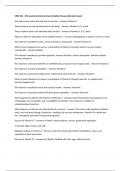MNE SDL - Micronutrients Review Exam Solution Manual Already Passed
This vitamin has stores that last only a few days. - Answers Vitamin K
These vitamins are stored extensively in the body. - Answers Vitamins A, D, and E
These vitamins have to be absorbed with micelles. - Answers Vitamins A, D, E, and K
What can limit the absorption of fat soluble vitamins? - Answers Maldigestion or absence of fat in a meal
This vitamin is needed for vision, immune function, and growth. - Answers Vitamin A
Which is more dangerous in excess, consumption of Vitamin A through retinol or as pro-vitamin
carotenoids? - Answers Retinol
This vitamin is needed for growth regulation, immune function, calcium absorption, and bone health. -
Answers Vitamin D
This vitamin is consumed with fish or fortified foods, produced in sun-exposed skin. - Answers Vitamin D
This vitamin is a critical antioxidant. - Answers Vitamin E
This vitamin is consumed in fatty foods, mainly those with seed oils. - Answers Vitamin E
Which is more dangerous in excess, consumption of Vitamin E through seed oils, or supplements? -
Answers Supplements
This vitamin is needed for bone and vascular health. - Answers Vitamin K
This vitamin is consumed mainly with dark-green vegetables. - Answers Vitamin K
What happens in patients with Vitamin A deficiency? - Answers Visual impairment and changes to eye
morphology, loss of appetite, and susceptibility to infection. Very common in children in
underdeveloped countries.
What happens in patients who take Vitamin A in excess? - Answers This occurs with ingestion of Retinol
only: Liver and bone damage, headaches, vomiting, dry mucous membranes. Vitamin A in retinol also
has a mutagenic potential during early pregnancy.
Sources of Vitamin A? - Answers In Plants: Sweet potatoes, carrots, green leafy vegetables
In Animals: Eggs, cheese, and milk
Biological activity of Vitamin A - Answers Control of cell growth (retinol metabolites), vision, and
regulation of gene expression
Sources of Vitamin D? - Answers UV-B light, fortified milk, fish, eggs, infant formula
, Biological activity of Vitamin D? - Answers Major function is to maintain serum calcium and phosphorous
levels by enhancing their absorption.
What happens to patients with a Vitamin D deficiency? - Answers Rickets, osteomalacia, osteoporosis,
lax muscles, risk of falls, diminished calcium absorption and retention, cancer.
What happens to patients who take Vitamin D in excess? - Answers May cause brain damage in young
infants, calcification of the arteries and other soft tissues.
What happens to patients with a Vitamin E deficiency? - Answers Peripheral neuropathy, hemolysis.
Very uncommon due to wide availability.
What happens to patients who take Vitamin E in excess? - Answers Increase risk of death from bleeding
and hemorrhagic stroke.
Biological activity of Vitamin E? - Answers Inactivates oxygen free radicals in membranes, lipoproteins,
and other lipid rich compartments. Possibly plays a specific role in fertility.
Sources of Vitamin E? - Answers Vegetable oils, nuts and seeds, margarine
Forms of Vitamin E? - Answers Natural form: RRR-alpha-tocopherol
Synthetic Form: Contains equal amounts of 8 sterioisomers; only half are highly available biologically.
What happens to patients with a Vitamin K deficiency? - Answers Prolonged bleeding time/bleeding
episodes. (Serves as a cofactor in blood coagulation)
What happens to patients who take Vitamin K in excess? - Answers No adverse effects have been
reported, though it may interfere with anticoagulant medication.
Sources of Vitamin K? - Answers Cooked greens, green vegetables, canola & soybean oil, intestinal
bacteria
Biological activity of Vitamin K? - Answers Important cofactor in blood coagulation, coenzyme in
synthesis of proteins involved in bone mineralization, several proteins involved in control of arterial
calcification are vitamin K-dependent.
These water soluble vitamins are essential for fuel metabolism. - Answers Thiamin (B1), Riboflavin (B2),
Niacin (B3), Vitamin B6 (pyridoxine), pantothenate, and biotin.
This vitamin is an enzyme cofactor, an antioxidant, and regenerates Vitamin E. - Answers Vitamin C
(ascorbic acid)
This vitamin is involved in DNA synthesis and one-carbon transfers. - Answers Folate
This vitamin is required for transamination of amino acids and for the conversion of homocysteine to
cysteine. - Answers Vitamin B6





